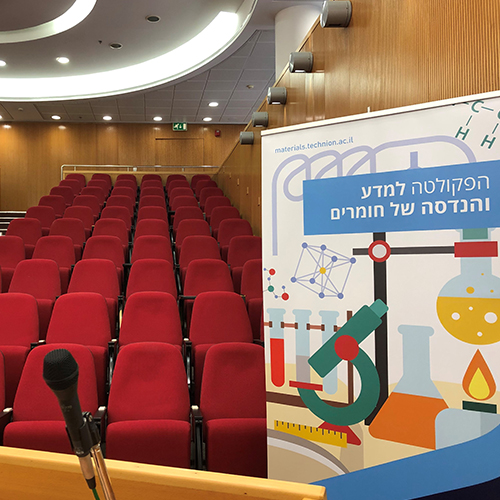
Mrs. Samah Saied-Ahmad - Ph.D. Candidate
04/12/2025
אודיטוריום ע"ש דויד וואנג, בניין מידן, קומה 3
13:30
Macroporous, biodegradable polyesters with structural tunability hold promise for biomedical applications. Here, macroporous polyester monoliths were synthesized through ring-opening polymerization (ROP) within oil-in-oil medium internal phase emulsions (MIPEs) containing ~60 wt% silicone oil as the internal phase. The study explored the effects of the stabilization strategy, synthesis conditions, crosslinking strategy, and foaming on macroporous polycaprolactone (PCL) monoliths. The investigation was then extended to phase-separated PCL-based block copolymers (BCPs) as well as to poly(L-lactide) (PLLA), poly(glycolide) (PGA), and poly(lactide-co-glycolide) (PLGA).
The synthesis conditions were successfully changed from 120 °C to 50 °C to room temperature UV exposure through the use of metal-free catalysts suitable for biomedical applications. The PCL monoliths exhibited densities of ~0.24 g/cc, average void diameters ranging from 5 to 40 μm, crystallinities ranging from 40 to 55%, and moduli ranging from 0.5 to 6 MPa. The formation of surfactant-free emulsions using nanoparticles or miktoarm brushes affected the macromolecular structure, the porous structure, and the properties. Varying the macromolecular architecture from crosslinked linear chains to linked-up star polymers also had significant effects on the properties. The PCL-based monoliths degraded completely within 5 h in 3 M NaOH and foaming, which reduced the density (~0.14 g/cc), accelerated the degradation. Degradation was significantly faster in the PLLA, PLA, and PLGA monoliths. The amorphous PLGA degraded within 2 h in 0.01 M NaOH, twice as fast as the crystalline PLLA or PGA monoliths. This work demonstrates that macroporous polyester monoliths with tunable structures, properties, and degradation rates can be achieved via the large number of parameters available for emulsion-templated ROP synthesis.


